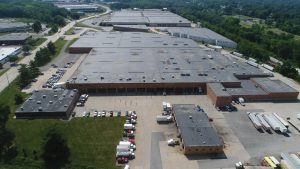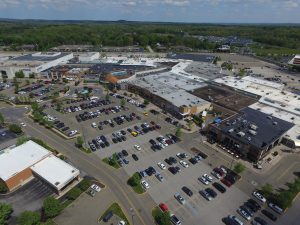— By Matt Malorni —
What facility managers need to know about roofing repairs, replacements and maintenance.
The roof is unquestionably the least visible part of a restaurant or a shopping center; however, if not given any attention it can cause the greatest number of problems. Facility managers and owners are faced not only with properly maintaining their roofing but also making decisions about how to handle issues to get the most life and value out of their roof. Repair versus replacement, tear off replacement versus layover replacement and full replacement versus partial replacement are all decisions that at some point will likely need to be made on a commercial building.

Matt Malorni, Legacy Roofing Services
Any discussion about roof repairs and replacements must begin with stressing the importance of preventative maintenance. No matter the roofing system, preventative maintenance is the most important way to keep a roof healthy and a budget stable. Preventing or minimizing problems is the best way to avoid costly repairs and replacements. Every commercial building should have a walk-over assessment at least twice a year to take a close look at the structural integrity of the roof as well as the condition of the roofing materials and elements. One of the biggest mistakes that can be made is thinking because a roof is new, or relatively new, it doesn’t need to be maintained the first few years. Nothing could be further from the truth. The best way to prolong the life of a roof is to put a preventative maintenance plan in place right away and many manufacturers give incentives for properly maintaining their roofing system, some going so far as extending the life of the warranty for up to 10 years.
When problems do occur, the first step is to have a roofing professional take an overview of the roof to look for deterioration in the roof system itself and the number of repairs it would take to keep the roof operational. A complete inspection of everything — including the membrane, flashings, decking and insulation — is needed to understand the overall health of the roof and make an accurate diagnosis.
 Under most circumstances, a core-cut should be done to verify the condition of the insulation. If it is deteriorated or wet, it needs replacement. Wet insulation can deteriorate not only the roofing but also the decking, causing incrementally greater damage and costs if left unaddressed. The condition of the insulation will often determine whether a repair or replacement is needed and if a replacement is warranted, what type. The general rule of thumb is if more than 20% of the insulation is wet or otherwise compromised, more than likely the roof would need a tear off replacement. Inspecting walls in the building and penetrations can also provide insight into the extent of any leaks.
Under most circumstances, a core-cut should be done to verify the condition of the insulation. If it is deteriorated or wet, it needs replacement. Wet insulation can deteriorate not only the roofing but also the decking, causing incrementally greater damage and costs if left unaddressed. The condition of the insulation will often determine whether a repair or replacement is needed and if a replacement is warranted, what type. The general rule of thumb is if more than 20% of the insulation is wet or otherwise compromised, more than likely the roof would need a tear off replacement. Inspecting walls in the building and penetrations can also provide insight into the extent of any leaks.
Next up is to look at the overall condition of the roof membrane or materials. If the materials are dried out, stretching, cracked or have seams that are coming apart, an assessment would need to be made on the cost of repairs versus replacement. Assuming the insulation and decking are in good condition, in most instances repairs would be able to prolong the life of the roof and avoid a costly replacement. This is obviously contingent on the number of repairs that need to be made; however, a cost analysis can easily provide insight into the best option.

Specific circumstances, such as the use of the building or space, need to be considered as well when determining necessary repairs and replacements. Restaurants, for example, may require installation of grease containment units, specific exhaust fans and ventilators to prevent the oil from reaching the roof membrane.
The age of the roofing is also a big determining factor as it relates to whether the building or space is a long term lease or ownership situation as opposed to a short term lease. If the facility is not going to be there very long, or if its specific usage is going to change, that is a consideration also because future needs are unknown.
When a replacement is the best option, the facility manager generally has three choices: tear off the existing roof and install a new one, install a second roof system over the existing one, or do a partial replacement with repairs being done on the other parts. Installing a second roof system over the existing roof, which is less expensive than a complete tear off, can be done when there is no or minimal underlying damage, usually because the roof has been regularly inspected and problems have not progressed to the insulation or decking. If problems have gone unaddressed and there is significant underlying damage, the 20% rule applies when deciding if a complete tear off is needed.
There are instances, however where other options can be feasible. If, for instance, the insulation is dry and the membrane is just getting old, it might be possible to just remove the membrane, save the insulation and replace the roof system. A partial replacement can be done when only a portion of the roof needs to be fully replaced and the remaining part can be cost effectively repaired. When a partial replacement is done, however, the new roofing system must be separated, or blocked off, from the old roofing system. This will prevent any issues still plaguing the old system from impacting the new one.
Roof traffic is another important consideration. Installing either a walkway system or a roof design that will allow for foot traffic can prevent costly damage and greatly extend the life of a roofing system and help avoid costly replacements.
A properly and regularly maintained roof is the best way to avert costly problems and can often be the difference between repairs and replacements or tear off replacements and layover replacements. It comes down to catching problems as early as possible and then making smart and informed decisions when work is required.
— Matt Malorni is service director of Legacy Roofing Services, one of the largest and most respected commercial and residential roofing service providers in Ohio & Pennsylvania. Legacy Roofing has three offices in Ohio and one in Pittsburgh.

